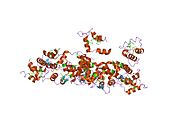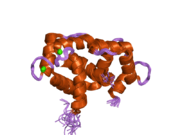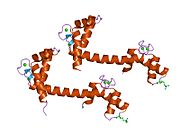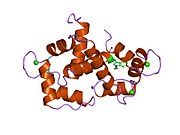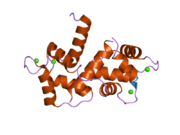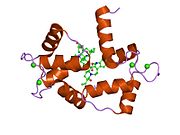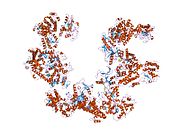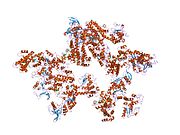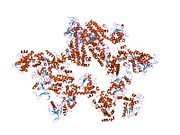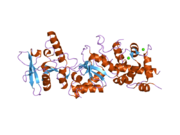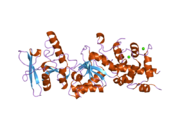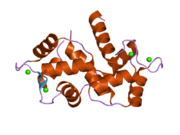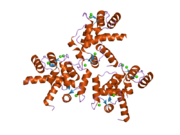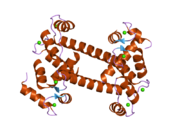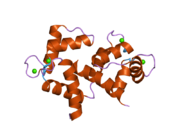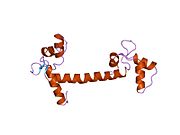Calmodulin 1
| View/Edit Human | |||
Calmodulin 1 is a protein in humans that is encoded by the CALM1 gene.[3]
Calmodulin[4] plays a role in calcium signal transduction pathways by regulating control of ion channels, enzymes, aquaporins, and other proteins. It functions as a calcium-binding protein that has been grouped into the EF-hand motif found in eukaryotic cells. Calmodulin plays a significant role in numerous cellular pathways and it acts as a calcium detector within the cells that interact with varied target proteins. Additionally, it simulates[5] the activation of over twenty amino acids which helps to control various physiological functions. It is also required for various regulatory roles in cell proliferation and throughout many points during the cell cycle.
Upon binding to targeted calcium (acts as ligand), calmodulin undergoes a change in shape that allows it to interact with multiple protein types including phosphatases, ion channels, and kinases. This conformational change is associated with undergoing various cellular processes: including muscle contraction, release of neurotransmitters into the bloodstream, and gene expression.
Function
Calmodulin 1 is the archetype of the family of calcium-modulated (calmodulin) proteins of which nearly 20 members have been found. They are identified by their occurrence in the cytosol or on membranes facing the cytosol and by a high affinity for calcium. Calmodulin contains 149 amino acids and has 4 calcium-binding EF hand motifs. Its functions include roles in growth and the cell cycle as well as in signal transduction and the synthesis and release of neurotransmitters.[6]
Gene expression
In humans, there are three genetic isoforms of calmodulin which are encoded by the homologous gene variations: CALM1, CALM2, and CALM3. Each three of the isoforms produce distinct, yet closely associated forms of calmodulin. At the nucleic acid level, the coding regions differ by a 15% between CALM1 and CALM2 and 13% between CALM2 and CALM3.[7]
Calmodulin I, abbreviated CALM1, is located on chromosome 14 of the human genome, and is one of the three isoforms of calmodulin. It’s found in all human tissues, although the expression varies depending on tissue type. There are high expression levels found in the brain, muscle, and blood.
Throughout the body, CALM1 plays a significant role in muscle contraction and relaxation in skeletal and smooth muscle. In heart muscle, CALM1 is vital for the regulation of calcium signaling to control efficient cardiac functioning. Calcium/calmodulin protein kinases (CaMKs)[8] work symbiotically to regulate calcium signaling throughout the body. CAMKII, the most prolific isoform, is found in cardiac tissue where it controls excitation-contraction coupling. Calmodulin I also plays an important role in the immune system through lymphocytes (white blood cells) where it contributes to immune cell function and activation. In bone tissue, Calmodulin I is associated with osteoblasts, osteoclasts, and osteocytes, by functioning in intracellular calcium signaling to ensure bone mineralization, resorption, and remodeling.
Calmodulin 1[7] can be expressed as one of two transcript types, which can be distinguished by length and tissue location. The major transcript is present in all tissues and is recorded as 1.7-kb in length. The minor transcript is either 4.1-kb or 4.4kb in length, and is only found in brain and skeletal muscle tissue. The difference in transcript lengths are caused by substitute cleavage and polyadenylation signals (APA), which permits the origination of different mRNA isoforms.
Pseudogenes
There are two known pseudogenes of Calmodulin 1, which are known as CALMIPI and CALMIP2. CALMPI was first discovered on chromosome 7, and the CALMPI2 was later identified on chromosome X. Experimentation shows both pseudogenes lack introns and have multiple mutations in their open reading frame, meaning that they cease all functions.
Mapping
Human[9] and rodent hybridized somatic cell panels show that complementary DNA for calmodulin I was localized to chromosome 14, with some cross hybridization activity on chromosome 7, and minor involvement on chromosome X.
Identifiers
| CALM1 Biochemical & Signaling Pathways[10]
Kyoto Encyclopedia of Genes and Genomes (KEGG):[11] | |
|---|---|
| hsa04020 | Calcium signaling pathway
|
| hsa04070 | Phosphatidylinositol signaling system |
| hsa04114 | Oocyte meiosis |
| hsa04270 | Vascular smooth muscle contraction |
| hsa04720 | Long-term potentiation |
| hsa04722 | Neurotrophin signaling pathway |
| hsa04740 | Olfactory transduction
|
| hsa04744 | Phototransduction |
| hsa04910 | Insulin signaling pathway |
| hsa04912 | GnRH signaling pathway |
| hsa04916 | Melanogenesi
|
| hsa05010 | Alzheimer's disease |
| hsa05214 | Glioma |
| Calmodulin I protein family domains: | |
|---|---|
| PF00036 | EF hand |
| PF08726 | Ca2+ insensitive EF hand |
| PF12763 | Cytoskeletal-regulatory complex EF hand |
| PF13202 | EF hand |
| PF13405 | EF-hand domain |
| PF13499 | EF-hand domain pair |
| PF13833 | EF-hand domain pair |
| PF14658 | EF-hand domain |
Interactions
Calmodulin 1 has been shown to
Mutations
Mutations of CALM1 CALM2 or CALM3 can lead to critical cardiac deficiencies including long QT syndrome (LQTS) and catecholaminergic polymorphic ventricular tachycardia (CPVT).[18] Studies investigating calmodulin-associated diseases have discovered multiple proteins modified by calmodulin that determine the virulence of the mutations, including the cardiac L-type calcium channel (LTCC) Cav1.2, the sarcoplasmic reticulum calcium release channel, and the ryanodine receptor 2 (RyR2).
CALM1 disease mutations are often diagnosed in patients aged ten or younger, whereas CALM2 and CALM3 mutations typically develop in adulthood. Calmodulin functioning defects cause interference of vital calcium signaling events within the heart muscle which disrupts membrane ion channels. The disruptions in cell signaling can lead to potentially life-threatening cardiac disturbances in adolescence.
- Long QT Syndrome-14 (LQT14)
LQT14[19] is caused by the heterozygous mutation in the CALM1 gene (114180) on chromosome 14q32. It often produces life-threatening ventricular arrhythmias that manifest at a young age with persistent periods of T-wave alternans, notably sustained QTc intervals, and irregular 2:1 atrioventricular blocks.
CPVT
It has been discovered that some individuals with CPVT have distinct mutations on the Calmodulin I gene. The mutations cause disruption in the proper functioning of the gene, which leads to abnormal calcium control in cardiac tissue cells. The calcium disturbance can trigger ventricular arrhythmias in reaction to blood vessel vasoconstriction, such as during periods of exercise or elevated stress.
References
- ^ a b c GRCh38: Ensembl release 89: ENSG00000198668 – Ensembl, May 2017
- ^ "Human PubMed Reference:". National Center for Biotechnology Information, U.S. National Library of Medicine.
- PMID 6385987.
- ^ "UniProt". www.uniprot.org. Retrieved 2023-10-11.
- PMID 1763137.
- ^ "Entrez Gene: CALM1 calmodulin 1 (phosphorylase kinase, delta)".
- ^ a b Hasterok S, Nyesiga B, Wingren AG (25 February 2022). "Calm-1". atlasgeneticsoncology.org. Retrieved 2023-10-11.
- PMID 32760284.
- ^ "Entry - *114180 - CALMODULIN 1; CALM1 - OMIM". www.omim.org. Retrieved 2023-10-11.
- ^ "Human Gene CALM1 (uc001xyl.2)". genome.ucsc.edu. Retrieved 2023-11-02.
- ^ "KEGG: Kyoto Encyclopedia of Genes and Genomes". www.genome.jp. Retrieved 2023-10-26.
- PMID 12221128.
- PMID 14695896.
- PMID 12446675.
- PMID 11734550.
- PMID 12051765.
- PMID 12808128.
- PMID 36629534.
- PMID 31170290.
- PMID 23040497.
Further reading
- Zhang M, Yuan T (1999). "Molecular mechanisms of calmodulin's functional versatility". Biochemistry and Cell Biology. 76 (2–3): 313–323. PMID 9923700.
- Gusev NB (October 2001). "Some properties of caldesmon and calponin and the participation of these proteins in regulation of smooth muscle contraction and cytoskeleton formation". Biochemistry. Biokhimiia. 66 (10): 1112–1121. S2CID 310781.
- Benaim G, Villalobo A (August 2002). "Phosphorylation of calmodulin. Functional implications". European Journal of Biochemistry. 269 (15): 3619–3631. PMID 12153558.
- Trudeau MC, Zagotta WN (May 2003). "Calcium/calmodulin modulation of olfactory and rod cyclic nucleotide-gated ion channels". The Journal of Biological Chemistry. 278 (21): 18705–18708. PMID 12626507.
External links
- UniProt.[1] Calm1 Human Gene
- S2CID 243222152, retrieved 2023-10-16

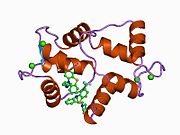

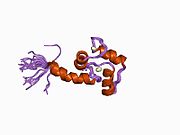


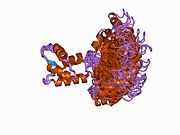
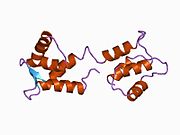
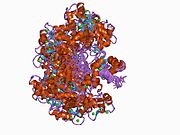
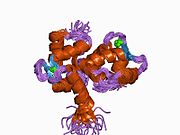

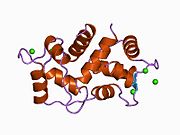



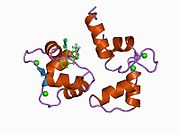


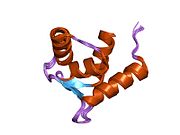



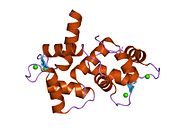


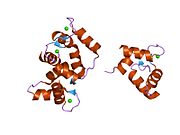




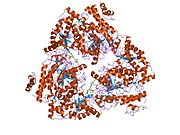

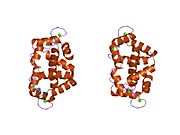
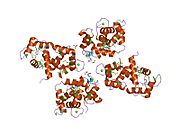




![1qiv: CALMODULIN COMPLEXED WITH N-(3,3,-DIPHENYLPROPYL)-N'-[1-R-(3,4-BIS-BUTOXYPHENYL)-ETHYL]-PROPYLENEDIAMINE (DPD), 1:2 COMPLEX](http://upload.wikimedia.org/wikipedia/commons/thumb/f/f1/PDB_1qiv_EBI.jpg/180px-PDB_1qiv_EBI.jpg)
![1qiw: CALMODULIN COMPLEXED WITH N-(3,3,-DIPHENYLPROPYL)-N'-[1-R-(3,4-BIS-BUTOXYPHENYL)-ETHYL]-PROPYLENEDIAMINE (DPD)](http://upload.wikimedia.org/wikipedia/commons/thumb/4/46/PDB_1qiw_EBI.jpg/180px-PDB_1qiw_EBI.jpg)



